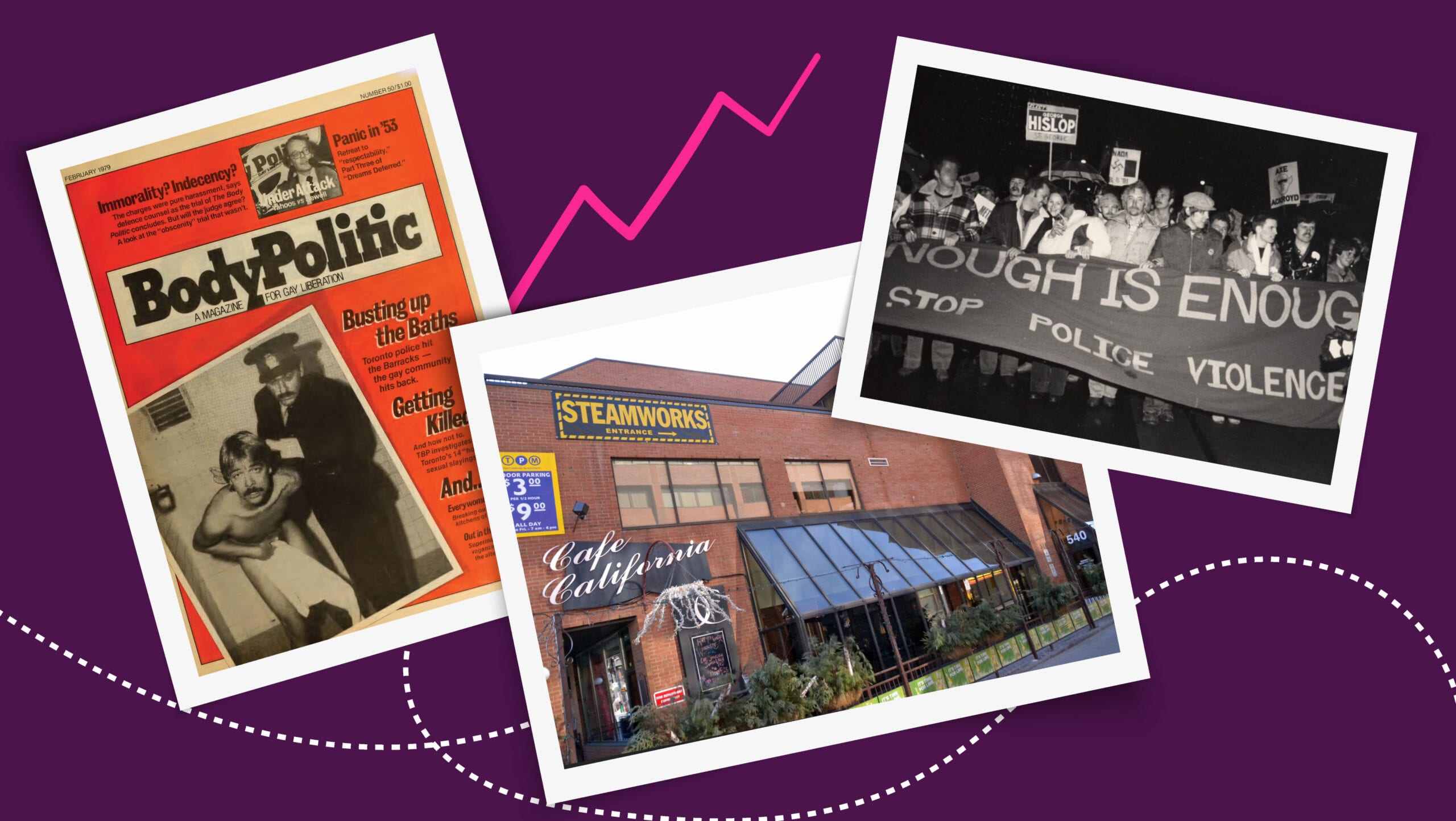Back in February, Toronto’s Spa Excess shut down for repairs after a laptop caught fire on a mattress in one of its rooms. Just as the renovated club was set to reopen in March, the province of Ontario ordered all non-essential businesses closed in an effort to stop the spread of COVID-19. The relaunch of the 22-year-old bathhouse, the city’s biggest, was called off. And when the province gradually allowed the full or partial reopening of various sectors of its economy—from hair salons to gyms to cinemas—a handful of categories of businesses were forced to remain on lockdown. Strip clubs, fine. Straight swingers’ clubs, fine. But “saunas, steam rooms, bath houses and oxygen bars?” Nope. That includes all six Ontario bathhouses that cater to men who have sex with men, along with karaoke bars, buffet-style restaurants and a handful of other business categories.
“I am worried about the future of these businesses,” says Toronto City Councillor Kristyn Wong-Tam, whose ward includes the city’s Gay Village. “I am also seeing injustice: Six businesses singled out and excluded from the recovery plan, largely because of the clientele that they serve.”
The Ontario government did eventually add strip clubs to its list of prohibited businesses, but Wong-Tam says it has not responded to proposals by bathhouse owners that would allow them to safely operate. The stakes are high. Already in the United States, two long-standing bathhouses—Washington, D.C.’s Crews Club and San José, California’s Watergarden—have gone permanently out of business following COVID-19 closures.
Of course, the gay bathhouse industry has been through this all before, targeted as a hotbed of viral (and moral) contagion. Though bathhouses are often cornerstone institutions of a robust queer scene—an indicator that a city is welcoming to gay residents and visitors—they have been demonized by authorities for much of modern history. But they can be profitable; demand for a safer place for casual sex has kept them alive. At least until COVID-19 came along.
“Though bathhouses are often cornerstone institutions of a robust queer scene—an indicator that a city is welcoming to gay residents and visitors—they have been demonized by authorities for much of modern history.”
On the moral side of the equation, bathhouse raids in Montreal and Toronto in the late 1970s and early ’80s showed the eagerness of police—some might call it an unrelenting obsession—to stop the “indecent acts” taking place inside their walls. Pushback from the LGBTQ2 community brought thousands out to Toronto streets in angry protest in 1981, eventually persuading authorities to leave bathhouses alone. Or so demonstrators thought. In 2000, for example, male plainclothes police officers raided a lesbian bathhouse night originally known as Pussy Palace (now Pleasure Palace). And it wasn’t until 2016 that Toronto Police Chief Mark Saunders apologized for the 1980s raids.
The perception of gay bathhouses as sites of viral contagion is most closely tied to the beginning of the AIDS crisis, which unfolded just a few years after the protests against bathhouse raids. As the medical community at the time came to realize that a serious new disease was disproportionately affecting gay men—it was originally called Gay-Related Immune Deficiency (GRID)—there were calls from both the public and officials in Canada and the United States to shut down bathhouses, because they were seen as encouraging risky sexual practices. Closures did happen in several cities—most notably the gay meccas of San Francisco and New York in 1984 and 1985, respectively—but elsewhere many bathhouses survived. In fact, throughout the AIDS crisis, many took on the role of HIV/AIDS education and outreach centres, places where not-strictly-sexual relationships and a sense of community might be formed.
“When they closed the baths in San Francisco, one of the big questions was whether it was even going to make any kind of difference,” says Tom Hooper, a historian of LGBTQ2 communities in Canada. “Opponents of the closures were saying, ‘It’s not where you do it, it’s how you do it.’ Shutting down a place like that is a violation of fundamental freedoms. If you’re going to shut down a space like that, you have to have a solid health-oriented justification for doing so.”
COVID-19—which makes not just sex but socializing risky to a person’s health—has come at a particularly tough time for an institution that has been a venue for the sexual liberation of generations of gay men. Although bathhouses are a uniquely gay concept—the promise of anonymous sexual fantasies in clouds of steam—they’ve also recently grappled with broader social trends that affect a wide cross-section of mainstream bricks-and-mortar enterprises. The rising cost of real estate and rent in major cities, combined with the competition from digital services that make smartphone consumerism easier and cheaper than heading to a physical address, have upended multiple industries—from fashion to dining to nightlife. For LGBTQ2 businesses specifically, apps have made it easier to meet and have sex in someone’s home, while increased social acceptance has provided many queers the freedom to look for fun, friendship and love in places other than queer venues. It’s still unclear how many businesses will go under because of COVID-19 closures, but when a bathhouse closes it’s rare that a new one comes along.
“It’s very difficult for a business of this nature to reopen,” says Wong-Tam. “The saunas, the private rooms, the bath and spa equipment—it’s not cheap. Building a modern 21st-century facility has significant start-up costs.”
Scholarly research and anecdotal evidence suggest that the number of bathhouses in North America peaked in the 1980s and has been declining ever since. In 2000, there were at least nine Toronto bathhouses catering to men who have sex with men; now, there are three.
Yet there’s still a demand. Firstly (and perhaps least profitably): these remain sites of resistance against forces trying to demonize queerness and casual sex, places that the community fought for in the face of police oppression and the AIDS crisis. Secondly, some guys just find them extremely hot. Thirdly, the modern bathhouse can be a refuge for men who are marginalized—closeted, at risk of violence, living in otherwise homophobic circumstances. A 2000 study of bathhouse behaviour in four U.S. cities found that men of colour, younger men and men with less access to education were more likely than others to patronize sex venues like bathhouses. Some patrons, like people who live with roommates or family, simply lack access to safe, private spaces where they can have sex.
“My personal view is that hardly anything should be open now due to COVID-19, but I don’t think bathhouses should be singled out,” says Alexander McClelland, an assistant professor at Carleton University who focuses on the intersections of life, law and disease. “Men are still hooking up with each other, and if spaces that can open can ensure that that can happen safely, then I would highly encourage that.”
Even San Francisco, a city that put all its bathhouses out of business 36 years ago, has reconsidered their value. In September, the city voted to revoke the 1984 bathhouse ban, allowing new ones to open after COVID-19-related restrictions are lifted.
“If there is a plucky entrepreneur out there who wants to raise the money, get a building and open a bathhouse, he or she can do it,” says Raphael Mandelman, the city supervisor (the equivalent of councillor) who introduced the bill. “The world has changed since they were closed,” he says, pointing to the accessibility of PrEP, the prescription drug regime that reduces or eliminates the risk of transmitting HIV/AIDS. In 1992, new HIV infections in San Francisco peaked at 3,326. “Our new HIV infections for 2019 were down to 166,” Mandelman says. “We’re not quite at zero, but we’ve made incredible progress.”
Though there was no flurry of applications for licences immediately after the bill passed, Mandelman says that post-COVID-19, bathhouses may end up being a more viable business in San Francisco than they were before the pandemic. This year the decline in residential rents in the famously expensive city “has been extraordinary,” says Mandelman. That will make the area more affordable for younger people. The empty storefronts and bankruptcies caused by COVID-19 closures also seem likely to push commercial rents down, making it cheaper to launch capital-intensive operations like bathhouses. Other North American cities, like Toronto, are also seeing COVID-19-driven rent decreases.
“COVID-19 is a terrible catastrophe,” Mandelman says. “However, there could be new possibilities coming out of it—including the possibility of a more sustainable economy that’s fairer, more equitable and includes more people.”
Will existing businesses survive long enough to take advantage of such new economic circumstances? They’ll need some way to pay the bills while the COVID-19 crisis continues—and that won’t be via customers unless governments, guided by facts not fear, take their future seriously. After the initial spring lockdown, Alberta, Manitoba, Quebec and Nova Scotia allowed gay bathhouses to reopen. Since then, Wong-Tam says, none have been linked to any cases of COVID-19 transmission. “And none of their local public health inspections have raised any issues.”
If bathhouses do go under—whether because of valid health issues or not—they’ll be taking a vibrant chapter in the history and culture of Canada’s LGBTQ2 community with them.


 Why you can trust Xtra
Why you can trust Xtra


